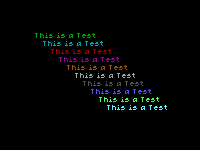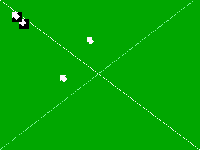Documentation for MODEX Pascal Library
Written By
Mike Chapin
This library is a set of routines for VGA ModeX written for 16
bit protected mode. This library came out of seeing all the ModeX
libraries that are written for C. I thought why should they have
all the fun. There was no problem with the C code since I work in
that language most of the time. Borland Pascal is fun to program
in and I'm not much of a language snob so I decided to port some
stuff over.
I also like to work in Borland Pascal also. This is because of
the almost instantanious compile and link times. It is a great
language for experimentation, And except for the lack of a huge
data model it will do anything C or C++ will.
I had a lot of code around from a GUI library I have been messing
with for a while. I also have code for a 16 bit C++ ModeX library
I did a couple of years back. With the exception of the font
routines, There is nothing found in here that cannot be found in
a gillion sources around the networks so I decided to put the
whole thing into public domain.
Most of the low level code here found its seeds in Michael Abrash
code that was originally published in "Power Graphics
Programming". Other code has its basis in the series he did for
"Dr. Dobb's Journal". Other code is based on stuff from my own
libraries that I have developed for other uses.
The code is designed to be the basis of a game library. I decided
to put this in proteced mode since the data requirements for even
a small 256 color game can require a lot of memory. I don't know
about you but I am very tired of having to strip my machine down
to the bare bones just to run a game. Protected mode programs
typically take about 200k of the lower 640k; just enough to load
the DOS extender and some code to handle it. I haven't used any
heavy duty routines from WinAPI yet so feel free to add them if
you want to.
This whole body of code is released into the public domain. Use
it and enjoy. Some of this stuff hasn't been tested as much as I
would like, i.e. read that I haven't done a game with this code.
So I assume no responsability if your computer gets offended and
walks out on you. The stuff that has been tested is in the demos.
Low Level Routines
Most of the low level routines are standard fare of setting
modes, going back to text mode and puting various stuff on the
screen. They are mostly self explanitory. The ones I will touch
on are the routines and structures that should have a little more
explanation.
The first item is that there is no clipping at the moment, even
on the mouse.
*****
Procedure UsePage(pagenum : Word);
This routine sets that page that all graphics functions will
write to.
Procedure ShowPage(pagenum : Word);
This routine controls what page will be shown on the screen.
Procedure FlipPage;
Sets the current write page to the current view page and
vice-versa. This is just a shorthand function for doing it
yourself each time with UsePage and ShowPage.
Procedure CopyPage(source, dest : Word);
Copies the full contents of one graphics page to another.
*****
Procedure BlockPageToPage(sourcepage, dest_page,
startx, starty, width, height,
destx, desty : Word);
This routine moves a portion of one page to another. startx and
destx will be forced to a DWORD boundry before the move is made.
This routine transfers a DWORD at a time and is very fast.
*****
Function GetPicMask(Var pic : PictHeader) : BytePtr;
Procedure CopyScreenToScreenMaskedX(sourcepage,
SourceStartX,
SourceStartY,
SourceWidth,
SourceHeight,
DestStartX,
DestStartY,
DestPageBase : Word;
masks : BytePtr);
These two functions work together to do pretty much the same
thing that BlockPageToPage does except it will tranfer using a
mask. GetPicMask will take a PictHeader structure and return an
array of masks for the picture. Every place there is a color 0,
a transparent area is formed. This array is passed to
CopyScreenToScreenMaskedX. CopyScreenToScreenMaskedX will
transfer irregular shaped objects from one screen to the other.
Picture Functions
Procedure GetPic(x, y, width, height : Word; Var pic : PictHeader);
Procedure PutPic(x, y : Word; Var p : PictHeader);
Procedure FreePic(Var pic : PictHeader);
These routines work together to save pictures from the screen,
put them back up and to free the memory associated with them when
you are finished. GetPic will make a buffer of the proper size
and lift an area off the screen. PutPic will place that picture
at the coordinates of the current Write Page. FreePic will free
up the buffer associated with PictHeader and zero out all the
fields. Pictures cannot be larger than 65520 bytes.
The format used for pictures is a planar type for speed. Each
plane is bytewidth wide and height high.
*****
Procedure PutMaskedPic(x, y : Word; Var p : PictHeader);
This does the same as PutPic except that color 0 is transparent.
Procedure SetScreenBuffers(Var s : ScreenPic);
Procedure FreeScreenBuffers(Var s : ScreenPic);
Procedure PutScreen(page : Word; Var s : ScreenPic);
Procedure GetScreen(page : Word; Var s : ScreenPic);
SetScreenBuffers allocates the memory needed to hold a full
screen. I have used four 19200 apiece. I did not use
GlobalAllocPtr because it simply allocates chunks of 64k and
another 11k or so with another selector. This would be awkward to
use for restroring screens.
FreeScreenBuffers frees up the memory allocated in SetScreen
Buffers. PutScreen and GetScreen do pretty much what you would
expect.
FONTS
This portion is from a GUI I am developing. It uses font data
that is similar to that used by PCX fonts with my own header. The
fonts are versitile enough to be brought in from a file or linked
in. All three types are demoed in the file FONTDEMO.PAS. The
original code would let you use the BIOS fonts on the machine but
the extender returns a bogus selector value so I had to pull that
code out. If anyone has figured out how to get around this I
would like to know. I left the original code but commented out.
 To use the linked fonts you must have an assembler to assemble
the font into an object file.
Two utilities are in the package GEM2PRF.EXE and PRF2ASM.EXE.
GEM2PRF converts a file in Gem format to my own format. This
allows you to use the gem fonts that come with GENUS and CSource
libraries. PRF2ASM will output an ASM file for use with a linked
font.
*****
Event Handler
The event handler is a rather simple affair. I just captures
keystrokes and mouse actions and puts them into a queue. Each
call to GetEvent will grab an event out of the queue if one is
availible. If there is a mouse present the handler will hook in
the interrupt handler to grab mouse events.
Call CloseEvents at the end of your program to unhook the mouse
event handler and free up the memory used by the queue.
This is a rather simple and safe event handler. I don't hook into
the keyboard interrupt to grab keystrokes. Instead I just grab
all the keystrokes and put them in the queue with a BIOS call in
each call to GetEvent. This makes everything nice and safe. I
have used this same event handler in conjuction with taking over
the keyboard interrupt. I haven't tried it under protected mode
but I'm sure it would work if someone cared to modify the
routines.
*****
The Mouse
This has all the standard mouse stuff and can be used without
using the event handler. Just make sure you unhook the interrupt
handler before leaving your program.
To use the linked fonts you must have an assembler to assemble
the font into an object file.
Two utilities are in the package GEM2PRF.EXE and PRF2ASM.EXE.
GEM2PRF converts a file in Gem format to my own format. This
allows you to use the gem fonts that come with GENUS and CSource
libraries. PRF2ASM will output an ASM file for use with a linked
font.
*****
Event Handler
The event handler is a rather simple affair. I just captures
keystrokes and mouse actions and puts them into a queue. Each
call to GetEvent will grab an event out of the queue if one is
availible. If there is a mouse present the handler will hook in
the interrupt handler to grab mouse events.
Call CloseEvents at the end of your program to unhook the mouse
event handler and free up the memory used by the queue.
This is a rather simple and safe event handler. I don't hook into
the keyboard interrupt to grab keystrokes. Instead I just grab
all the keystrokes and put them in the queue with a BIOS call in
each call to GetEvent. This makes everything nice and safe. I
have used this same event handler in conjuction with taking over
the keyboard interrupt. I haven't tried it under protected mode
but I'm sure it would work if someone cared to modify the
routines.
*****
The Mouse
This has all the standard mouse stuff and can be used without
using the event handler. Just make sure you unhook the interrupt
handler before leaving your program.
 The standard mouse handler does not know how to put a mouse image
on the screen in ModeX so you have to take over the operation of
showing and hiding the mouse yourself. The way the mouse is drawn
is that it uses and 16x16 pixel picture for the mouse. You can
use MouseSetCursor to change the picture used for the mouse. The
mouse is always drawn on the current Write Page. The data
structure rodent carries all the information for the mouse.
The mouse can be displayed two ways. The first method is the
normal method the mouse is used. To use this method set
rodent.savebg to True. If you are going to do a lot of page
flipping and contiually wiping over the area where the mouse is
you might want to call the mouse routines that put the cursor on
the screen yourself. For this set rodent.savebg to False and call
PutMouseImage directly.
Limitations:
Right now the mouse does not clip. Also you should keep the hot
spot to 0, 0. I have not put in any code to handle the edges in
this case. I can almost guarantee a protection fault if you try
to draw below SegA000.
Have fun!
Mike Chapin
GEnie M.CHAPIN
Compuserve 71420,560
The standard mouse handler does not know how to put a mouse image
on the screen in ModeX so you have to take over the operation of
showing and hiding the mouse yourself. The way the mouse is drawn
is that it uses and 16x16 pixel picture for the mouse. You can
use MouseSetCursor to change the picture used for the mouse. The
mouse is always drawn on the current Write Page. The data
structure rodent carries all the information for the mouse.
The mouse can be displayed two ways. The first method is the
normal method the mouse is used. To use this method set
rodent.savebg to True. If you are going to do a lot of page
flipping and contiually wiping over the area where the mouse is
you might want to call the mouse routines that put the cursor on
the screen yourself. For this set rodent.savebg to False and call
PutMouseImage directly.
Limitations:
Right now the mouse does not clip. Also you should keep the hot
spot to 0, 0. I have not put in any code to handle the edges in
this case. I can almost guarantee a protection fault if you try
to draw below SegA000.
Have fun!
Mike Chapin
GEnie M.CHAPIN
Compuserve 71420,560
|  Mike Chapin
Mike Chapin
 Mike Chapin
Mike Chapin